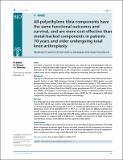Files in this item
All-polyethylene tibia components have the same functional outcomes and survival, and are more cost-effective than metal-backed components in patients 70 years and older undergoing total knee arthroplasty : propensity match study with a minimum five-year follow-up
Item metadata
| dc.contributor.author | Jabbal, Abhimanyu Monu | |
| dc.contributor.author | Clement, Nick | |
| dc.contributor.author | Walmsley, Phillip Jonathan | |
| dc.date.accessioned | 2023-01-09T15:30:15Z | |
| dc.date.available | 2023-01-09T15:30:15Z | |
| dc.date.issued | 2022-12-15 | |
| dc.identifier | 282720809 | |
| dc.identifier | e2b961e5-e5ec-41de-b440-1d3fbcc1caa6 | |
| dc.identifier | 85144356327 | |
| dc.identifier.citation | Jabbal , A M , Clement , N & Walmsley , P J 2022 , ' All-polyethylene tibia components have the same functional outcomes and survival, and are more cost-effective than metal-backed components in patients 70 years and older undergoing total knee arthroplasty : propensity match study with a minimum five-year follow-up ' , Bone & Joint Open , vol. 3 , no. 12 , pp. 969-976 . https://doi.org/10.1302/2633-1462.312.BJO-2022-0063.R1 | en |
| dc.identifier.issn | 2633-1462 | |
| dc.identifier.uri | https://hdl.handle.net/10023/26723 | |
| dc.description | Funding: The open access fee for this study was funded by the Roy Petrie Fund, NHS Fife. | en |
| dc.description.abstract | Aims The tibial component of total knee arthroplasty can either be an all-polyethylene (AP) implant or a metal-backed (MB) implant. This study aims to compare the five-year functional outcomes of AP tibial components to MB components in patients aged over 70 years. Secondary aims are to compare quality of life, implant survivorship, and cost-effectiveness. Methods A group of 130 patients who had received an AP tibial component were matched for demographic factors of age, BMI, American Society of Anesthesiologists (ASA) grade, sex, and preoperative Knee Society Score (KSS) to create a comparison group of 130 patients who received a MB tibial component. Functional outcome was assessed prospectively by KSS, quality of life by 12-Item Short-Form Health Survey questionnaire (SF-12), and range of motion (ROM), and implant survivorships were compared. The SF six-dimension (6D) was used to calculate the incremental cost effectiveness ratio (ICER) for AP compared to MB tibial components using quality-adjusted life year methodology. Results The AP group had a mean KSS-Knee of 83.4 (standard deviation (SD) 19.2) and the MB group a mean of 84.9 (SD 18.2; p = 0.631), while mean KSS-Function was 75.4 (SD 15.3) and 73.2 (SD 16.2 p = 0.472), respectively. The mental (44.3 vs 45.1; p = 0.464) and physical (44.8 vs 44.9; p = 0.893) dimensions of the SF-12 and ROM (97.9° vs 99.7°; p = 0.444) were not different between the groups. Implant survivorship at five years were 99.2% and 97.7% (p = 0.321). The AP group had a greater SF-6D gain of 0.145 compared to the MB group, with an associated cost saving of £406, which resulted in a negative ICER of -£406/0.145 = -£2,800. Therefore, the AP tibial component was dominant, being a more effective and less expensive intervention. Conclusion There were no differences in functional outcomes or survivorship at five years between AP and MB tibial components in patients aged 70 years and older, however the AP component was shown to be more cost-effective. In the UK, only 1.4% of all total knee arthroplasties use an AP component; even a modest increase in usage nationally could lead to significant financial savings. | |
| dc.format.extent | 8 | |
| dc.format.extent | 478956 | |
| dc.language.iso | eng | |
| dc.relation.ispartof | Bone & Joint Open | en |
| dc.subject | RD Surgery | en |
| dc.subject | E-NDAS | en |
| dc.subject | SDG 3 - Good Health and Well-being | en |
| dc.subject | MCC | en |
| dc.subject.lcc | RD | en |
| dc.title | All-polyethylene tibia components have the same functional outcomes and survival, and are more cost-effective than metal-backed components in patients 70 years and older undergoing total knee arthroplasty : propensity match study with a minimum five-year follow-up | en |
| dc.type | Journal article | en |
| dc.contributor.institution | University of St Andrews. School of Medicine | en |
| dc.identifier.doi | 10.1302/2633-1462.312.BJO-2022-0063.R1 | |
| dc.description.status | Peer reviewed | en |
This item appears in the following Collection(s)
Items in the St Andrews Research Repository are protected by copyright, with all rights reserved, unless otherwise indicated.

